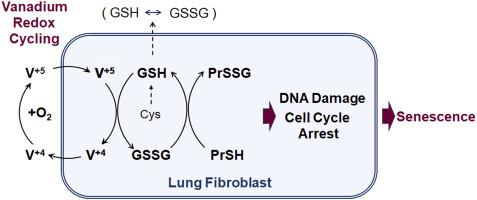Redox Biology ( IF 10.7 ) Pub Date : 2022-07-16 , DOI: 10.1016/j.redox.2022.102409 Xiaojia He 1 , Zachery R Jarrell 1 , Yongliang Liang 1 , Matthew Ryan Smith 1 , Michael L Orr 1 , Lucian Marts 1 , Young-Mi Go 1 , Dean P Jones 1

|
Both environmental exposure to vanadium pentoxide (V2O5, V+5 for its ionic counterparts) and fibroblast senescence are associated with pulmonary fibrosis, but whether V+5 causes fibroblast senescence remains unknown. We found in a dose-response study that 2–40 μM V+5 caused human lung fibroblasts (HLF) senescence with increased senescence-associated β-galactosidase activity and p16 expression, while cell death occurred at higher concentration (LC50, 82 μM V+5). Notably, measures of reactive oxygen species (ROS) production with fluorescence probes showed no association of ROS with V+5-dependent senescence. Preloading catalase (polyethylene-conjugated), a H2O2 scavenger, did not alleviate the cellular senescence induced by V+5. Analyses of the cellular glutathione (GSH) system showed that V+5 oxidized GSH, increased GSH biosynthesis, stimulated cellular GSH efflux and increased protein S-glutathionylation, and addition of N-acetyl cysteine inhibited V+5-elevated p16 expression, suggesting that thiol oxidation mediates V+5-caused senescence. Moreover, strong correlations between GSSG/GSH redox potential (Eh), protein S-glutathionylation, and cellular senescence (R2 > 0.99, p < 0.05) were present in V+5-treated cells. Studies with cell-free and enzyme-free solutions showed that V+5 directly oxidized GSH with formation of V+4 and GSSG in the absence of O2. Analyses of V+5 and V+4 in HLF and culture media showed that V+5 was reduced to V+4 in cells and that a stable V+4/V+5 ratio was rapidly achieved in extracellular media, indicating ongoing release of V+4 and reoxidation to V+5. Together, the results show that V+5-dependent fibroblast senescence is associated with a cellular/extracellular redox cycling mechanism involving the GSH system and occurring under conditions that do not cause cell death. These results establish a mechanism by which environmental vanadium from food, dietary supplements or drinking water, can cause or contribute to lung fibrosis in the absence of high-level occupational exposures and cytotoxic cell death.
中文翻译:

五氧化二钒诱导人肺成纤维细胞氧化应激和细胞衰老
环境暴露于五氧化二钒(V 2 O 5,V +5为其离子对应物)和成纤维细胞衰老均与肺纤维化相关,但 V +5是否导致成纤维细胞衰老仍不清楚。我们在一项剂量反应研究中发现,2–40 μM V +5会导致人肺成纤维细胞 (HLF) 衰老,并增加衰老相关的 β-半乳糖苷酶活性和 p16 表达,而细胞死亡发生在较高浓度(LC 50 , 82 μM V +5 )。值得注意的是,用荧光探针测量活性氧(ROS)产生表明ROS与V +5依赖性衰老没有关联。预加载过氧化氢酶(聚乙烯共轭)(一种 H 2 O 2清除剂)并不能减轻 V +5诱导的细胞衰老。对细胞谷胱甘肽(GSH)系统的分析表明,V +5氧化 GSH,增加 GSH 生物合成,刺激细胞 GSH 外流并增加蛋白质 S-谷胱甘肽化,并且添加 N-乙酰半胱氨酸抑制 V +5 -升高的 p16 表达,表明硫醇氧化介导 V +5引起的衰老。此外, V +5处理的细胞 中存在GSSG/GSH 氧化还原电位 (E h )、蛋白质 S-谷胱甘肽化和细胞衰老之间的强相关性 (R 2 > 0.99,p < 0.05)。对无细胞和无酶溶液的研究表明,在没有 O 2的情况下, V +5直接氧化 GSH,形成 V +4和 GSSG 。对 HLF 和培养基中V +5和 V +4的分析表明,细胞内 V +5降至 V +4,并且细胞外培养基中快速达到稳定的 V +4 /V +5比率,表明持续释放V +4并再氧化为V +5。总之,结果表明,V +5依赖性成纤维细胞衰老与涉及 GSH 系统的细胞/细胞外氧化还原循环机制有关,并且在不导致细胞死亡的条件下发生。这些结果建立了一种机制,在没有高水平职业暴露和细胞毒性细胞死亡的情况下,来自食物、膳食补充剂或饮用水的环境钒可以导致或促成肺纤维化。











































 京公网安备 11010802027423号
京公网安备 11010802027423号